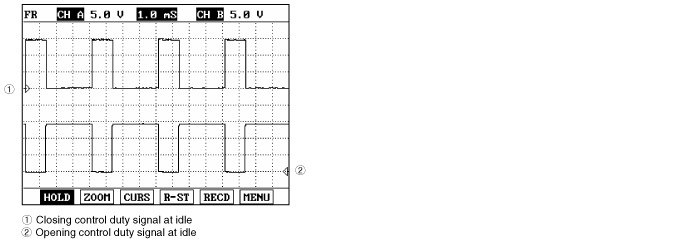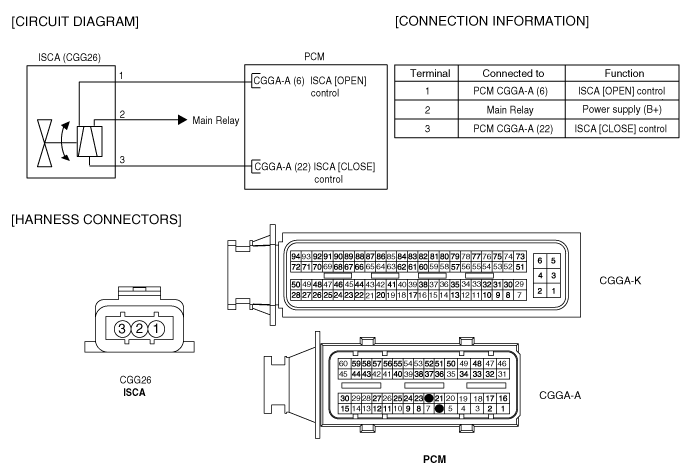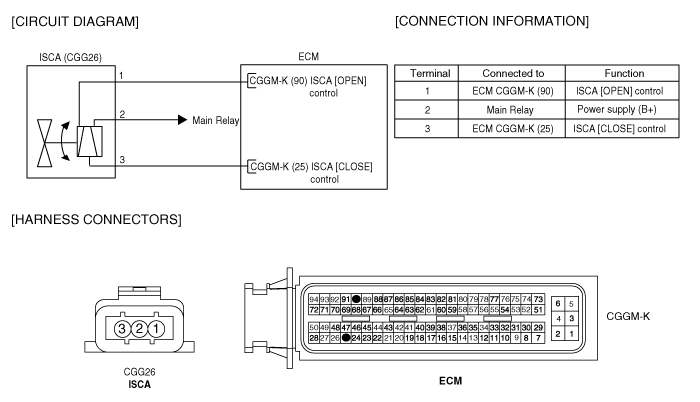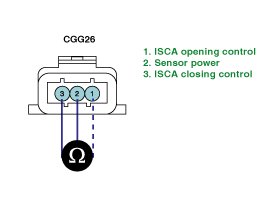Read "DTC Status" parameter.


The ISCA (Idle Speed Control Actuator) is designed to maintain a steady desired idle speed. Idle airflow is adjusted through the idle air actuator in order to maintain the desired idle speed under various load conditions. Load conditions vary due to numerous factors, such as engine temperature, air conditioning, electrical load and power steering load.
If actual engine speed is more than 100 rpm lower than desired engine speed, P0506 is set.
Item | Detecting Condition | Possible Cause |
DTC Strategy | ● Rationality check, low | ● Poor connection ● Clog in intake air system ● Carbon pile ● ISCA |
Enable Conditions | ● Vehicle speed = 0 ● Coolant temperature > 70℃ ● Intake air temperature > -6℃ ● Altitude < 3000m ● Idle status ● No error on the related sensors. (VSS,ECTS,IATS,etc) ● Idle speed control torque > 14.84% ● Engine load < 35% ● No error on the PCV ● Monitoring of VSS is ended | |
Threshold Value | ● Desired engine speed - Engine speed 〉 100rpm | |
Diagnostic Time | ● 8 sec | |
MIL ON Condition | ● 2 driving cycle |

Temperature [℃(℉)] | Closing Coil Resistance (Ω) | Opening Coil Resistance (Ω) |
20 (68) | 14.6 ~ 16.2 | 11.1 ~ 12.7 |


Connect scantool to Data Link Connector(DLC).
IG "ON".
Select "Diagnostic Trouble Codes(DTCs)" mode, and then Press F4(DTAL) to check DTC'sinformation from the DTCs menu
Confirm that "DTC Readiness Flag" indicates "Complete". If not, drive the vehicle within conditionsnoted in the freeze frame data or enable conditions noted in the DTC detecting condition.
Read "DTC Status" parameter.

Is parameter displayed "History(Not Present) fault"?
History fault : DTC occurred but has been cleared.
Present fault : DTC is occurring at present time.

▶ Fault is intermittent caused by poor contact in the sensor’s and/or ECM’s connector or wasrepaired and ECM memory was not cleared. Thoroughly check connectors for looseness,poor connection, bending, corrosion, contamination, deterioration, or damage.Repair or replace as necessary and then go to "Verification of Vehicle Repair" procedure.

▶ Go to "Terminal & Connector Inspection" procedure
Many malfunctions in the electrical system are caused by poor harness and terminals. Faults can also be caused by interference from other electrical systems, and mechanical or chemical damage.
Thoroughly check connectors for looseness, poor connection, bending, corrosion, contamination, deterioration, or damage.
Has a problem been found?

▶ Repair as necessary and go to "Verification of vehicle Repair" procedure.

▶ Go to "System inspection" procedure.
Visual Inspection.
Check "Air intake/exhaust system."
▶ Check looseness, deterioration or contamination on air cleaner, throttle body and gasket.
▶ Check contamination, damage or clog on exhaust gas system.
Is the air intake/exhaust system O.K?

▶ Go to "Component inspection" procedure.

▶ Repair as necessary and go to "Verification of vehicle Repair" procedure.
ISCA visual check.
Key "OFF".
Disassemble ISCA.
Check contamination, damage or stuck on ISCA.
Check the operating sound when key turns "OFF" to "ON".
Is ISCA O.K?

▶ Go to "ISCA check" procedure.

▶ Substitute with a known - good ISCA and check for proper operation.
▶ If the problem is corrected, replace ISCA and go to "Verification of Vehicle Repair" procedure.
ISCA check.
Key "OFF".
Disassemble ISCA.
Measure the resistance between terminal 1 and 2 of ISCA harness connector. (Component side)
Measure the resistance between terminal 2 and 3 of ISCA harness connector. (Component side)
Temperature [℃(℉)] | Closing Coil Resistance (Ω) | Opening Coil Resistance (Ω) |
20 (68) | 14.6 ~ 16.2 | 11.1 ~ 12.7 |

Is the measured resistance within specifications?

▶ Many malfunctions in the electrical system are caused by poor harness(es) and terminals. Faults can also be caused by interference from other electrical systems, and mechanical or chemical damage. So, check poor connections and the related circuit between ECM and component thoroughly. Repair as necessary and go to "Verification of Vehicle Repair" procedure.

▶ Substitute with a known - good ISCA and check for proper operation.
▶ If the problem is corrected, replace ISCA and go to "Verification of Vehicle Repair" procedure.
After a repair, it is essential to verify that the fault has been corrected.
Connect scan tool and select "Diagnostic Trouble Codes(DTCs)" mode.
Press F4(DTAL) and confirm that "DTC Readiness Flag" indicates "Complete".
If not, drive the vehicle within conditions noted in the freeze frame data or enable conditions.
Read "DTC Status" parameter.
Is parameter displayed "History(Not Present) fault"?

▶ System performing to specification at this time. Clear the DTC.

▶ Go to the applicable troubleshooting procedure.